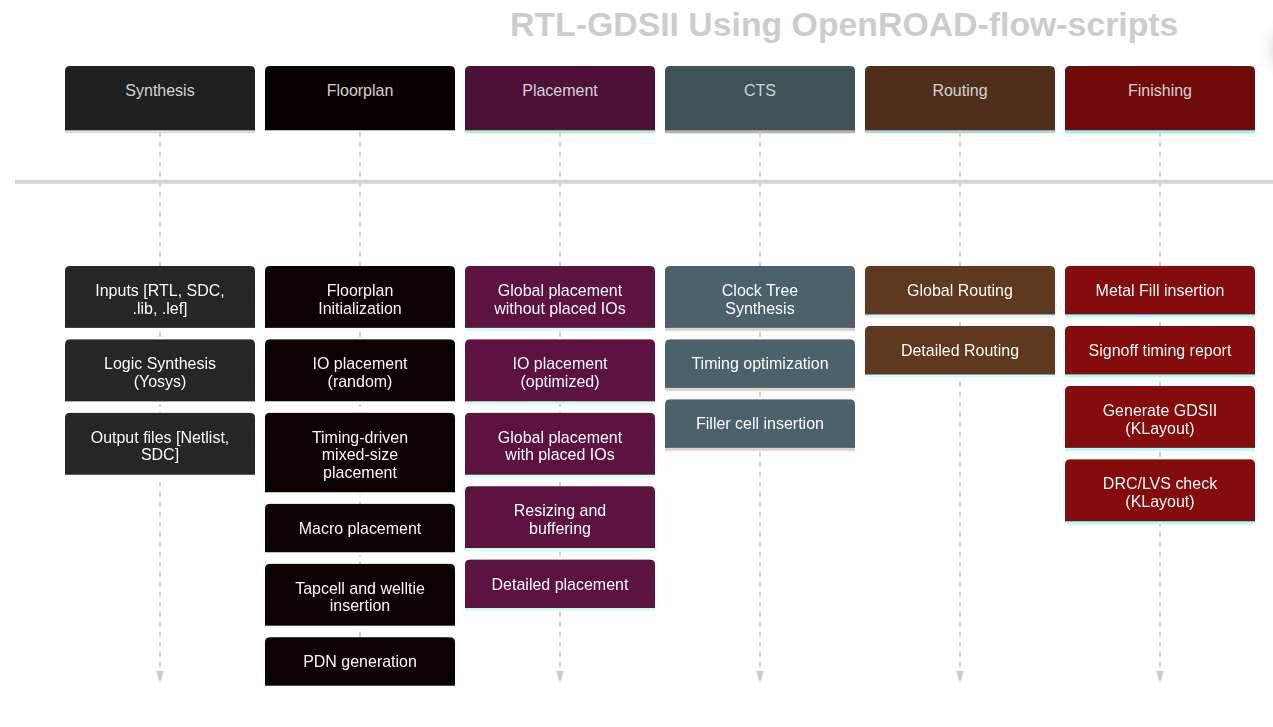chip-tutorials
OpenROAD Flow Scripts (ORFS) Walkthrough
Running an example design
This assumes that the smoke test runs and you’ve installed ORFS properly.
The documentation is available at ReadTheDocs.
The general steps of ORFS are shown here:

ORFS uses a Makefile to run the flow scripts. Specifically, it goes through the following steps that you see in the output of a successful run:
Log Elapsed seconds Peak Memory/MB
1_1_yosys 0 42
1_1_yosys_canonicalize 0 38
2_1_floorplan 0 97
2_2_floorplan_macro 0 93
2_3_floorplan_tapcell 0 93
2_4_floorplan_pdn 0 95
3_1_place_gp_skip_io 0 94
3_2_place_iop 0 94
3_3_place_gp 1 194
3_4_place_resized 0 113
3_5_place_dp 0 99
4_1_cts 4 120
5_1_grt 10 213
5_2_route 17 1175
5_3_fillcell 0 97
6_1_fill 0 95
6_1_merge 1 390
6_report 0 137
Total 33 1175
- 1_1_yosys: logic synthesis with Yosys
- 1_1_yosys_canonicalize
- 2_1_floorplan: determines floorplan area and aspect ratio
- 2_2_floorplan_macro: places fixed size macro blocks (e.g. SRAMs)
- 2_3_floorplan_tapcell:
- 2_4_floorplan_pdn: creates power ring and/or power straps
- 3_1_place_gp_skip_io:
- 3_2_place_iop: places the IO cells around the perimeter
- 3_3_place_gp: performs global placement of the gates
- 3_4_place_resized: performs global placement timing optimization, resizing gates, buffering, etc.
- 3_5_place_dp: performs detailed placement of the gates
- 4_1_cts: performs clock tree synthesis (CTS) to build the clock tree
- 5_1_grt: performs global routing
- 5_2_route: performs detailed routing
- 5_3_fillcell: adds fill cells to row places without cells
- 6_1_fill: adds routing fill to the design
- 6_1_merge: merges the GDS of library cells into the design
- 6_report: performs final design reporting, including timing, area, and power
Running different designs and technologies
While running make ran the default design, you can pass a variable to the Makefile with a configuration file
to run other designs. The default runs this:
make DESIGN_CONFIG=./designs/nangate45/gcd/config.mk
You can implement this in the ASAP7 technology by using this config:
make DESIGN_CONFIG=./designs/asap7/gcd/config.mk
The general format is:
make DESIGN_CONFIG=designs/<PLATFORM>/<DESIGN>/config.mk
where PLATFORM is the technology used (e.g. nangate45, asap7, etc.) and DESIGN is the design name (e.g. gcd).
Viewing the final design
To view the last design in the OpenROAD GUI, you can run:
make DESIGN_CONFIG=./designs/nangate45/gcd/config.mk gui_final
Cleaning up
There are targets to clean individual steps, or the entire flow. The individual steps are:
- clean_synth
- clean_floorplan
- clean_place
- clean_cts
- clean_route
- clean_finish
The entire flow is:
- clean_all
For example, you can clean an entire design with:
make DESIGN_CONFIG=./designs/asap7/gcd/config.mk clean_all
Running individual steps
You can also specify what step to run to run until with make:
make DESIGN_CONFIG=designs/<PLATFORM>/<DESIGN>/config.mk <STEP>
where STEP can be synth, floorplan, place, cts, route or finish. This is useful if you are having a problem with global routing, for example. To debug it, you can repeat cleaning and making like this:
make DESIGN_CONFIG=designs/<PLATFORM>/<DESIGN>/config.mk clean_route
make DESIGN_CONFIG=designs/<PLATFORM>/<DESIGN>/config.mk route
As long as you don’t change any features that affect the design, this is ok. However, if you change a feature that modifies the floorplan, for example, you will need to clean the floorplan and run from that step again.
Interactive TCL usage
If you want to use OpenROAD interactively, you need to first your path by sourcing the environment script.
The Makefile is smart enough to not require this, but if you are running openroad directly, you
will need to do this. For example,
source env.sh
You can then see that you are using the correct version of OpenROAD by running:
which openroad
which should point to
OpenROAD-flow-scripts/tools/install/OpenROAD/bin/openroad
Then, to get an interactive TCL console:
make DESIGN_CONFIG=designs/<PLATFORM>/<DESIGN>/config.mk bash
source env.sh
openroad <TLC file>
This bash script sets a bunch of environment variables (e.g., SCRIPTS_DIR,
LEF_FILES, LIB_FILES, etc.) so that you can use the ORFS scripts in
flow/scripts. For example you can very easily read a design after CTS in TCL with:
source $::env(SCRIPTS_DIR)/load.tcl
load_design 4_cts.odb 4_cts.sdc
Because you have specified the config file, it knows which design and technology, so you only have to specify the ODB file and SDC constraints.
Directory structure
The results (output files) are put in results/<PLATFORM>/<DESIGN>/base,
where <PLATFORM> is the technology used (e.g. nangate45, asap7, etc.),
<DESIGN> is the design name (e.g. gcd). The results directory is created
if it does not exist.
The log files are put in logs/<PLATFORM>/<DESIGN>/base. There is one
log file per flow step.
The reports (e.g. timing, area, power) are put in
reports/<PLATFORM>/<DESIGN>/base. Each step has reports depending on what
it does.
Config files
The config files contain parameters for the design, such as the technology, the input files, the constraints, etc. The important parts of a config file are:
# Specifies the technology subdirectory.
export PLATFORM = nangate45
# Input file list (a single file or a list of files).
export VERILOG_FILES = $(DESIGN_HOME)/src/$(DESIGN_NAME)/gcd.v
# The timing constraint file.
export SDC_FILE = $(DESIGN_HOME)/$(PLATFORM)/$(DESIGN_NAME)/constraint.sdc
# It picks a floorplan size so that the logic cells use 55\% of the area.
export CORE_UTILIZATION ?= 55
You can see all of the flow variable options documented here: Flow Variables
There are a lot of default variables that get set, but the config file
overrides them. The make bash target sources the default settings and
your config file for a particular technology and design.
Help
There is an ORFS tutrorial.
OpenROAD has some options for help via the man command like most
Unix systems. These manual pages provide detailed information about how to use
a particular command or function, along with its syntax and options.
This can be used for a range of commands in different levels as follows:
- Level 1: Top-level openroad command (e.g.
man openroad) - Level 2: Individual module/TCL commands (e.g.
man clock_tree_synthesis) - Level 3: Info, error, warning messages (e.g.
man CTS-0001)
The OpenROAD documentation is available at ReadTheDocs.
License
Copyright 2025 VLSI-DA (see LICENSE for use)